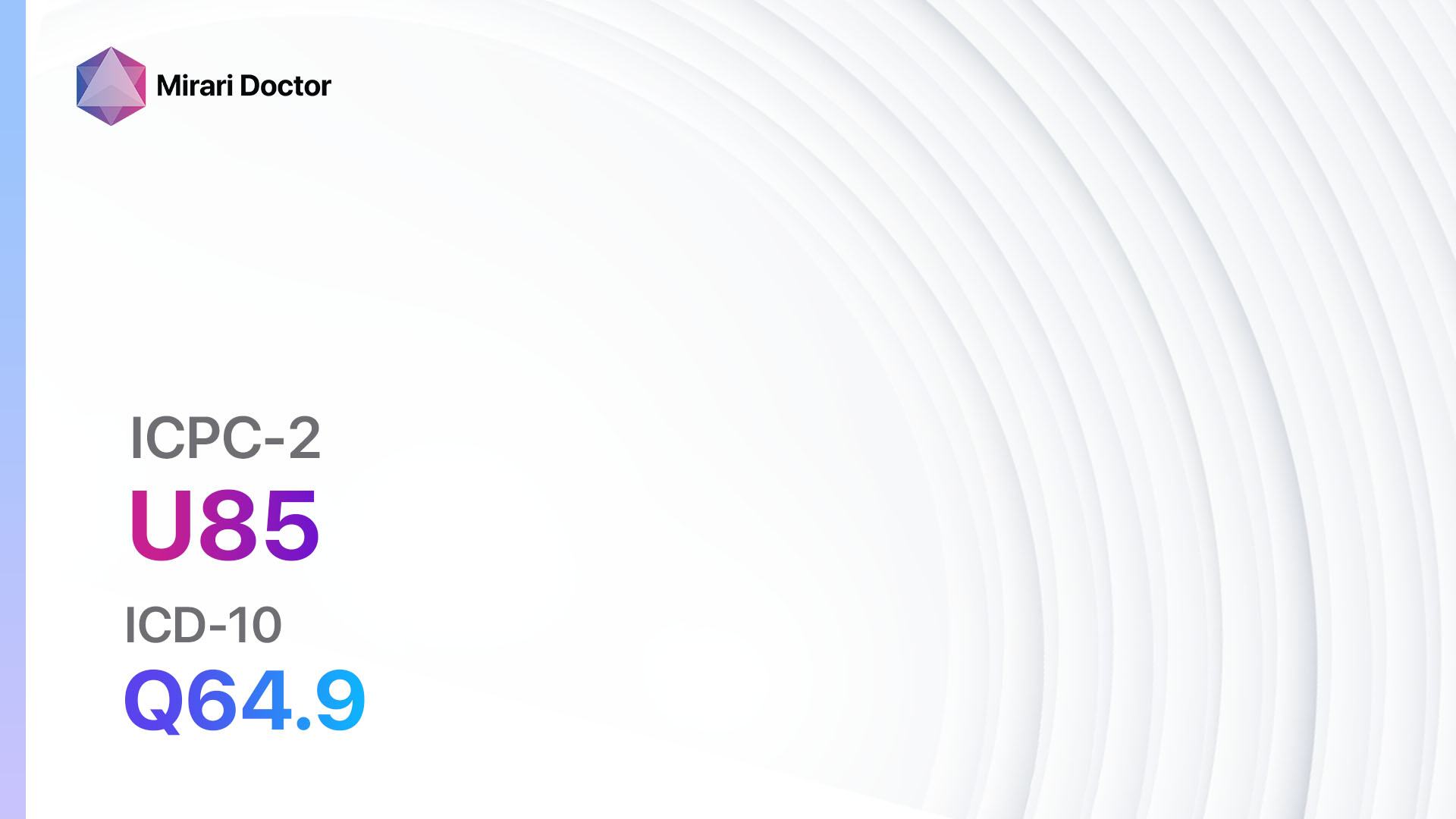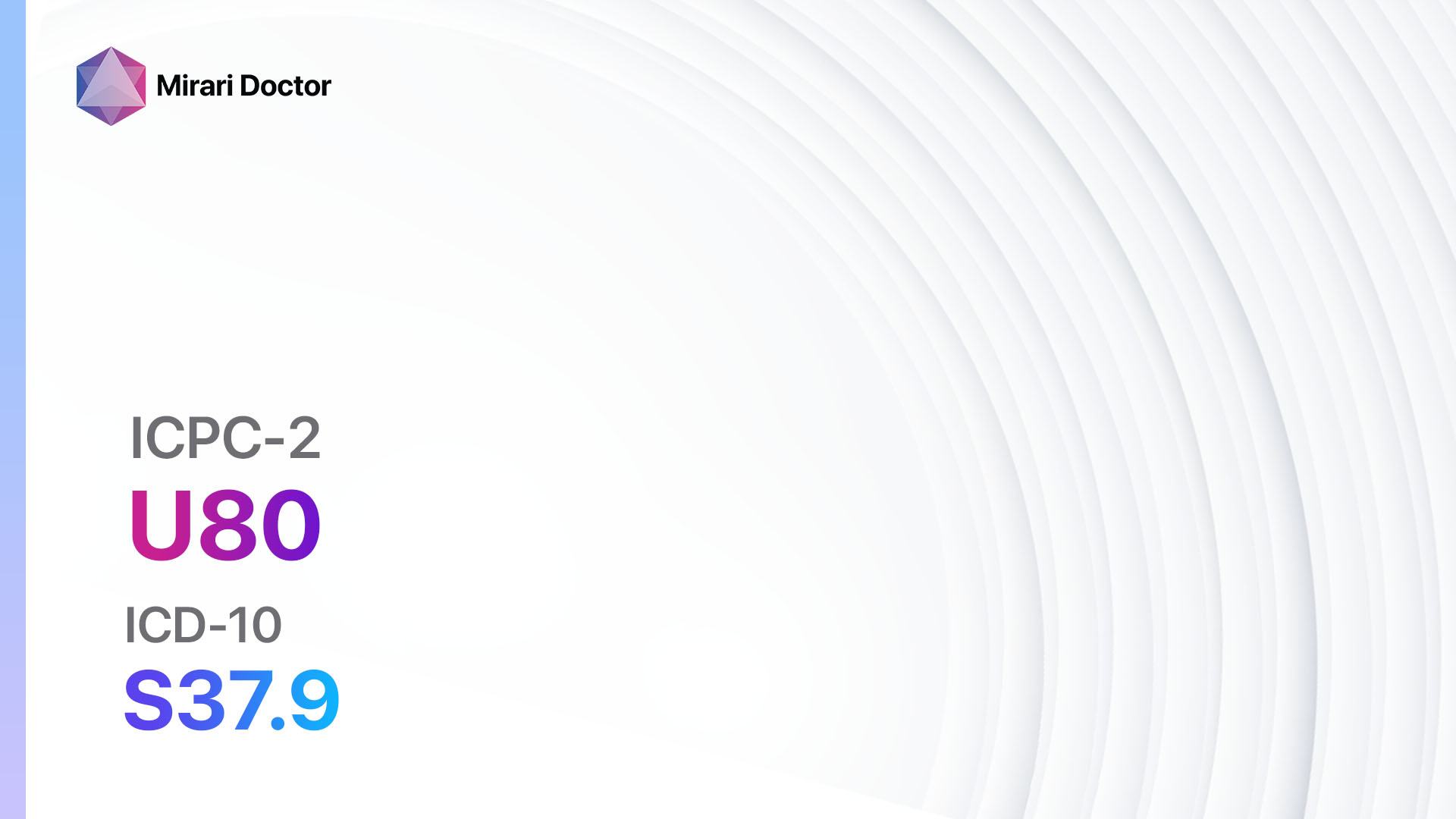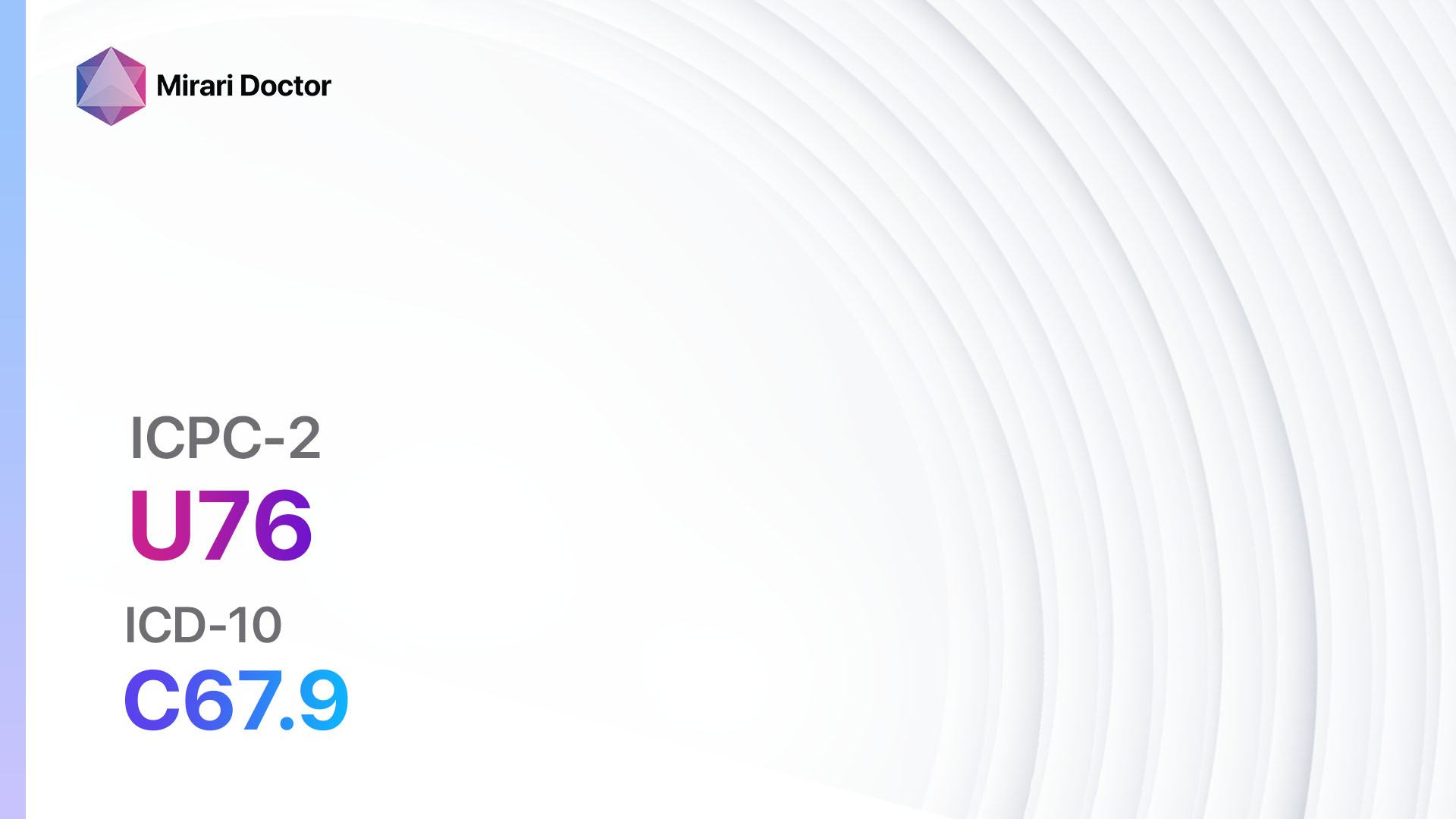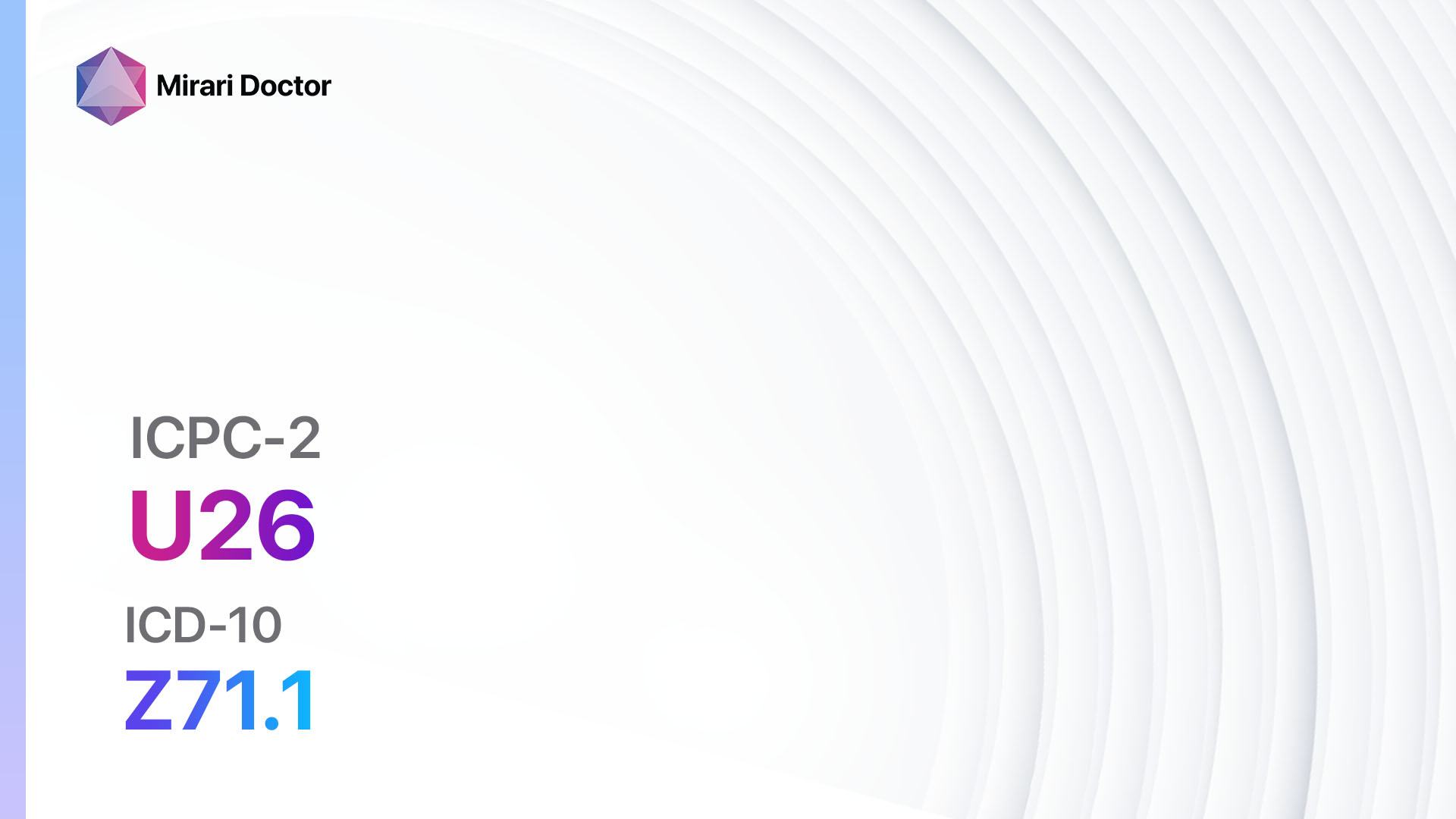
Introduction
Urinary diseases encompass a wide range of conditions that affect the urinary system, including the kidneys, bladder, ureters, and urethra. While some urinary diseases are well-known, such as urinary tract infections and kidney stones, there are other less common urinary diseases that require proper diagnosis and management[1]. This guide aims to provide healthcare professionals with a comprehensive approach to diagnosing and managing urinary disease, other (ICPC-2: U99).
Codes
- ICPC-2 Code: U99 Urinary disease other
- ICD-10 Code: N39.9 Disorder of urinary system, unspecified[2]
Symptoms
- Frequent urination: Increased frequency of urination, often accompanied by a sense of urgency.
- Painful urination: Discomfort or pain during urination.
- Blood in urine: Presence of blood in the urine, which may be visible or detected through laboratory tests.
- Lower abdominal pain: Pain or discomfort in the lower abdomen.
- Urinary incontinence: Involuntary leakage of urine.
- Urinary retention: Inability to completely empty the bladder.
- Urinary urgency: Sudden and strong urge to urinate.
- Changes in urine color or odor: Unusual color or odor of urine[3].
Causes
- Urinary tract infections: Bacterial infection of the urinary tract.
- Kidney stones: Hard deposits of minerals and salts that form in the kidneys.
- Bladder or kidney cancer: Abnormal growth of cells in the bladder or kidneys.
- Urinary tract obstruction: Blockage in the urinary tract, often due to an enlarged prostate or urinary stones.
- Urinary incontinence: Weak or overactive bladder muscles.
- Interstitial cystitis: Chronic inflammation of the bladder wall.
- Neurogenic bladder: Dysfunction of the bladder due to nerve damage.
- Urinary retention: Weakened bladder muscles or blockage in the urinary tract.
- Medications: Certain medications can cause urinary symptoms as a side effect.
- Other underlying medical conditions: Diabetes, kidney disease, and certain autoimmune disorders can contribute to urinary symptoms[4][5].
Diagnostic Steps
Medical History
- Gather information about the patient’s symptoms, including the duration, severity, and any triggering factors.
- Assess the patient’s medical history, including any previous urinary tract infections, kidney stones, or bladder or kidney conditions.
- Inquire about the patient’s medication use, as certain medications can cause urinary symptoms.
- Ask about the presence of any underlying medical conditions, such as diabetes or autoimmune disorders.
- Evaluate the patient’s lifestyle factors, such as fluid intake, diet, and exercise habits[6].
Physical Examination
- Perform a general physical examination to assess the patient’s overall health.
- Conduct a focused examination of the abdomen and pelvic region to check for any abnormalities or tenderness.
- Palpate the bladder to assess for distension or masses.
- Perform a digital rectal examination in male patients to evaluate the prostate gland.
- Assess for any neurological deficits that may contribute to urinary symptoms[7].
Laboratory Tests
- Urinalysis: Analyze a urine sample for the presence of blood, infection, or other abnormalities.
- Urine culture and sensitivity: Identify the specific bacteria causing a urinary tract infection and determine the most effective antibiotic treatment.
- Blood tests: Measure kidney function, electrolyte levels, and markers of inflammation or infection[8].
- Imaging studies: X-rays, ultrasound, CT scans, or MRIs may be ordered to visualize the urinary tract and identify any structural abnormalities or tumors[9].
- Cystoscopy: Insert a thin tube with a camera into the urethra and bladder to visualize the interior and collect tissue samples if necessary[10].
- Urodynamic testing: Assess bladder and urethral function by measuring pressure and flow rates during urination.
Follow-up and Patient Education
- Schedule follow-up appointments to monitor the patient’s progress and adjust treatment as needed.
- Provide education on proper hygiene practices to prevent urinary tract infections.
- Discuss lifestyle modifications, such as dietary changes and fluid management, to improve urinary symptoms.
- Address any concerns or questions the patient may have regarding their condition or treatment.
Possible Interventions
Traditional Interventions
Medications:
Top 5 drugs for Urinary disease, other (ICPC-2: U99):
- Antibiotics (e.g., Ciprofloxacin, Nitrofurantoin):
- Cost: Generic versions can range from $3 to $50 per month.
- Contraindications: Hypersensitivity to the medication.
- Side effects: Nausea, diarrhea, allergic reactions.
- Severe side effects: Tendon rupture, severe allergic reactions.
- Drug interactions: Warfarin, certain antacids.
- Warning: Use with caution in patients with renal impairment.
- Alpha-blockers (e.g., Tamsulosin, Alfuzosin):
- Cost: Generic versions can range from $10 to $50 per month.
- Contraindications: Hypersensitivity to the medication, severe liver impairment.
- Side effects: Dizziness, headache, low blood pressure.
- Severe side effects: Priapism, angioedema.
- Drug interactions: Other alpha-blockers, certain antihypertensive medications.
- Warning: Orthostatic hypotension may occur.
- Antispasmodics (e.g., Oxybutynin, Tolterodine):
- Cost: Generic versions can range from $10 to $50 per month.
- Contraindications: Urinary retention, gastric retention, uncontrolled narrow-angle glaucoma.
- Side effects: Dry mouth, constipation, blurred vision.
- Severe side effects: Urinary retention, hallucinations.
- Drug interactions: Other anticholinergic medications, certain antidepressants.
- Warning: Use with caution in elderly patients.
- Diuretics (e.g., Furosemide, Hydrochlorothiazide):
- Cost: Generic versions can range from $3 to $30 per month.
- Contraindications: Anuria, hepatic coma, severe electrolyte depletion.
- Side effects: Frequent urination, electrolyte imbalances.
- Severe side effects: Dehydration, hypotension.
- Drug interactions: Lithium, certain antihypertensive medications.
- Warning: Monitor electrolyte levels regularly.
- Pain relievers (e.g., Acetaminophen, Ibuprofen):
- Cost: Generic versions can range from $3 to $20 per month.
- Contraindications: Hypersensitivity to the medication, severe liver or kidney disease.
- Side effects: Upset stomach, dizziness, rash.
- Severe side effects: Liver or kidney damage, severe allergic reactions.
- Drug interactions: Warfarin, certain antidepressants.
- Warning: Avoid excessive use and follow recommended dosages.
Alternative Drugs:
- Botulinum toxin injections: Used for overactive bladder, cost can range from $500 to $1500 per treatment.
- Hormone replacement therapy: For postmenopausal women with urinary symptoms, cost can vary depending on the specific treatment.
- Immunosuppressive medications: Used in certain autoimmune conditions affecting the urinary system, cost can vary depending on the specific medication.
- Antidepressants: Can be used for certain urinary conditions, cost can vary depending on the specific medication.
- Antifungal medications: Used for fungal urinary tract infections, cost can vary depending on the specific medication.
Surgical Procedures:
- Transurethral resection of the prostate (TURP): Surgical removal of prostate tissue to relieve urinary obstruction. Cost: $10,000 to $20,000.
- Lithotripsy: Non-invasive procedure to break up kidney stones using shock waves. Cost: $10,000 to $15,000.
- Cystectomy: Surgical removal of the bladder, often followed by urinary diversion. Cost: $50,000 to $100,000.
- Ureteroscopy: Minimally invasive procedure to remove or break up stones in the ureter or kidney. Cost: $5,000 to $10,000.
- Nephrectomy: Surgical removal of a kidney, often performed for kidney cancer or severe kidney disease. Cost: $50,000 to $100,000.
Alternative Interventions
- Acupuncture: May help alleviate urinary symptoms and improve overall well-being. Cost: $60 to $120 per session.
- Herbal supplements: Certain herbs, such as cranberry extract and saw palmetto, may have potential benefits for urinary health. Cost: Varies depending on the specific supplement.
- Pelvic floor exercises: Strengthening the pelvic floor muscles can help improve urinary incontinence. Cost: Free.
- Bladder training: Techniques to gradually increase the time between urination to improve bladder control. Cost: Free.
- Biofeedback: Using electronic devices to provide feedback and help train the pelvic floor muscles. Cost: $100 to $200 per session.
Lifestyle Interventions
- Fluid management: Adjusting fluid intake to avoid excessive urination or dehydration. Cost: Free.
- Dietary modifications: Avoiding bladder irritants, such as caffeine and spicy foods. Cost: Varies depending on food choices.
- Weight management: Losing weight can help alleviate urinary symptoms in overweight or obese individuals. Cost: Varies depending on weight loss methods.
- Smoking cessation: Quitting smoking can improve urinary symptoms and overall health. Cost: Varies depending on smoking cessation methods.
- Stress management: Techniques such as meditation or yoga can help reduce stress-related urinary symptoms. Cost: Varies depending on chosen method.
It is important to note that the cost ranges provided are approximate and may vary depending on the location and availability of the interventions. Healthcare professionals should consider individual patient factors and preferences when recommending interventions for urinary disease, other (ICPC-2: U99).
Mirari Cold Plasma Alternative Intervention
Understanding Mirari Cold Plasma
- Safe and Non-Invasive Treatment: Mirari Cold Plasma is a safe and non-invasive treatment option for various skin conditions. It does not require incisions, minimizing the risk of scarring, bleeding, or tissue damage.
- Efficient Extraction of Foreign Bodies: Mirari Cold Plasma facilitates the removal of foreign bodies from the skin by degrading and dissociating organic matter, allowing easier access and extraction.
- Pain Reduction and Comfort: Mirari Cold Plasma has a local analgesic effect, providing pain relief during the treatment, making it more comfortable for the patient.
- Reduced Risk of Infection: Mirari Cold Plasma has antimicrobial properties, effectively killing bacteria and reducing the risk of infection.
- Accelerated Healing and Minimal Scarring: Mirari Cold Plasma stimulates wound healing and tissue regeneration, reducing healing time and minimizing the formation of scars.
Mirari Cold Plasma Prescription
Video instructions for using Mirari Cold Plasma Device – U99 Urinary disease other (ICD-10:N39.9)
| Mild | Moderate | Severe |
| Mode setting: 1 (Infection) Location: 2 (Prostate & Uterus) Morning: 15 minutes, Evening: 15 minutes |
Mode setting: 1 (Infection) Location: 2 (Prostate & Uterus) Morning: 30 minutes, Lunch: 30 minutes, Evening: 30 minutes |
Mode setting: 1 (Infection) Location: 2 (Prostate & Uterus) Morning: 30 minutes, Lunch: 30 minutes, Evening: 30 minutes |
| Mode setting: 6 (Liver/Kidney Therapy) Location: 2 (Prostate & Uterus) Morning: 15 minutes, Evening: 15 minutes |
Mode setting: 6 (Liver/Kidney Therapy) Location: 2 (Prostate & Uterus) Morning: 30 minutes, Lunch: 30 minutes, Evening: 30 minutes |
Mode setting: 6 (Liver/Kidney Therapy) Location: 2 (Prostate & Uterus) Morning: 30 minutes, Lunch: 30 minutes, Evening: 30 minutes |
| Mode setting: 6 (Liver/Kidney Therapy) Location: 3 (Kidney, Liver & Spleen) Morning: 15 minutes, Evening: 15 minutes |
Mode setting: 6 (Liver/Kidney Therapy) Location: 3 (Kidney, Liver & Spleen) Morning: 30 minutes, Lunch: 30 minutes, Evening: 30 minutes |
Mode setting: 6 (Liver/Kidney Therapy) Location: 3 (Kidney, Liver & Spleen) Morning: 30 minutes, Lunch: 30 minutes, Evening: 30 minutes |
| Mode setting: 7 (Immunotherapy) Location: 1 (Sacrum) Morning: 15 minutes, Evening: 15 minutes |
Mode setting: 7 (Immunotherapy) Location: 1 (Sacrum) Morning: 30 minutes, Lunch: 30 minutes, Evening: 30 minutes |
Mode setting: 7 (Immunotherapy) Location: 1 (Sacrum) Morning: 30 minutes, Lunch: 30 minutes, Evening: 30 minutes |
| Total Morning: 60 minutes approx. $10 USD, Evening: 60 minutes approx. $10 USD |
Total Morning: 120 minutes approx. $20 USD, Lunch: 120 minutes approx. $20 USD, Evening: 120 minutes approx. $20 USD, |
Total Morning: 120 minutes approx. $20 USD, Lunch: 120 minutes approx. $20 USD, Evening: 120 minutes approx. $20 USD, |
| Usual treatment for 7-60 days approx. $140 USD – $1200 USD | Usual treatment for 6-8 weeks approx. $2,520 USD – $3,360 USD |
Usual treatment for 3-6 months approx. $5,400 USD – $10,800 USD
|
 |
|
Use the Mirari Cold Plasma device to treat Urinary disease, other effectively.
WARNING: MIRARI COLD PLASMA IS DESIGNED FOR THE HUMAN BODY WITHOUT ANY ARTIFICIAL OR THIRD PARTY PRODUCTS. USE OF OTHER PRODUCTS IN COMBINATION WITH MIRARI COLD PLASMA MAY CAUSE UNPREDICTABLE EFFECTS, HARM OR INJURY. PLEASE CONSULT A MEDICAL PROFESSIONAL BEFORE COMBINING ANY OTHER PRODUCTS WITH USE OF MIRARI.
Step 1: Cleanse the Skin
- Start by cleaning the affected area of the skin with a gentle cleanser or mild soap and water. Gently pat the area dry with a clean towel.
Step 2: Prepare the Mirari Cold Plasma device
- Ensure that the Mirari Cold Plasma device is fully charged or has fresh batteries as per the manufacturer’s instructions. Make sure the device is clean and in good working condition.
- Switch on the Mirari device using the power button or by following the specific instructions provided with the device.
- Some Mirari devices may have adjustable settings for intensity or treatment duration. Follow the manufacturer’s instructions to select the appropriate settings based on your needs and the recommended guidelines.
Step 3: Apply the Device
- Place the Mirari device in direct contact with the affected area of the skin. Gently glide or hold the device over the skin surface, ensuring even coverage of the area experiencing.
- Slowly move the Mirari device in a circular motion or follow a specific pattern as indicated in the user manual. This helps ensure thorough treatment coverage.
Step 4: Monitor and Assess:
- Keep track of your progress and evaluate the effectiveness of the Mirari device in managing your Urinary disease, other. If you have any concerns or notice any adverse reactions, consult with your health care professional.
Note
This guide is for informational purposes only and should not replace the advice of a medical professional. Always consult with your healthcare provider or a qualified medical professional for personal advice, diagnosis, or treatment. Do not solely rely on the information presented here for decisions about your health. Use of this information is at your own risk. The authors of this guide, nor any associated entities or platforms, are not responsible for any potential adverse effects or outcomes based on the content.
Mirari Cold Plasma System Disclaimer
- Purpose: The Mirari Cold Plasma System is a Class 2 medical device designed for use by trained healthcare professionals. It is registered for use in Thailand and Vietnam. It is not intended for use outside of these locations.
- Informational Use: The content and information provided with the device are for educational and informational purposes only. They are not a substitute for professional medical advice or care.
- Variable Outcomes: While the device is approved for specific uses, individual outcomes can differ. We do not assert or guarantee specific medical outcomes.
- Consultation: Prior to utilizing the device or making decisions based on its content, it is essential to consult with a Certified Mirari Tele-Therapist and your medical healthcare provider regarding specific protocols.
- Liability: By using this device, users are acknowledging and accepting all potential risks. Neither the manufacturer nor the distributor will be held accountable for any adverse reactions, injuries, or damages stemming from its use.
- Geographical Availability: This device has received approval for designated purposes by the Thai and Vietnam FDA. As of now, outside of Thailand and Vietnam, the Mirari Cold Plasma System is not available for purchase or use.
References
- Kidney Disease: Improving Global Outcomes (KDIGO) CKD Work Group. KDIGO 2012 Clinical Practice Guideline for the Evaluation and Management of Chronic Kidney Disease. Kidney Int Suppl. 2013;3:1-150.
- World Health Organization. International Statistical Classification of Diseases and Related Health Problems (ICD-10). 2019.
- Kidney Disease: Improving Global Outcomes (KDIGO) Glomerulonephritis Work Group. KDIGO Clinical Practice Guideline for Glomerulonephritis. Kidney Int Suppl. 2012;2:139-274.
- Nicolaou N, et al. Genetic, environmental, and epigenetic factors involved in CAKUT. Nature Reviews Nephrology. 2015;11(12):720-731.
- Chevalier RL. Congenital Anomalies of the Kidneys and Urinary Tract. NeoReviews. 2019;20(5):e280-e289.
- Rabinowitz R. Bladder Anomalies. MSD Manual Professional Edition. 2023.
- Morey AF, et al. Urotrauma: AUA guideline. Journal of Urology. 2014;192(2):327-335.
- Summerton DJ, et al. EAU guidelines on iatrogenic trauma. European Urology. 2012;62(4):628-639.
- Lange-Sperandio B, et al. Congenital Anomalies of the Kidney and Urinary Tract: A Continuum of Care. Seminars in Nephrology. 2023;43(5):551-563.
- Stonebrook E, et al. Congenital Anomalies of the Kidney and Urinary Tract: A Clinical Review. Pediatric Nephrology. 2020;35(5):753-761.
Related articles
Made in USA



























